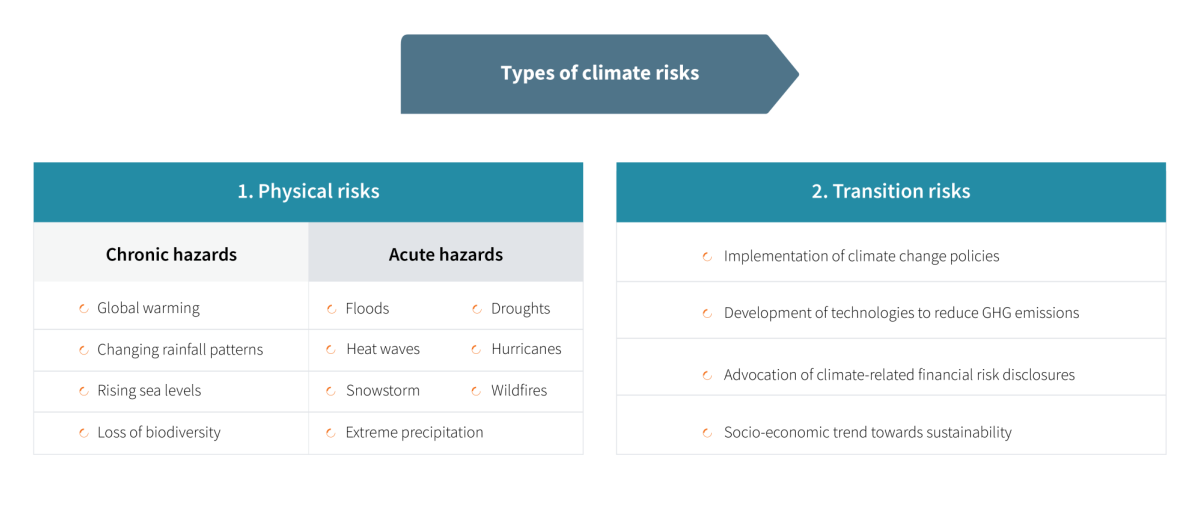In this article, we look at the different types of climate risks and how they can potentially be integrated with the various financial risk classes – credit risk, market risk, operational risk, and liquidity risk.
Climate risks often refer to the potential physical and transition effects of climate change. As shown in Figure 1, there are two types of climate risks:

Physical risks can be segregated into acute and chronic hazards, where the former encompasses periodic extreme weather events, and the latter refers to the progressive shifts in climate patterns that crystalise over a longer period of time. Transition risks, on the other hand, are business-related risks that follow societal and economic shifts towards a low-carbon economy.1
Despite the segregation of climate risks into different categories, it is important to recognise that all categories are correlated.
How do climate change risk categories integrate with traditional financial risk taxonomies?
Credit risk
Credit risk is the risk of financial loss resulting from a borrower’s failure to repay part of or all the interests and the principal of a loan, taking into account the borrower’s Probability of Default (PD), Loss Given Default (LGD), and Exposure at Default (EAD). While physical climate risks, such as extreme weather conditions can have an immediate destructive impact on tangible assets and disrupt day-to-day business operations, transition risks have an impact on the long-term going concern of companies belonging to carbon-intensive industries.
Market risk
Market risk is the risk that the market value of an asset will fall. Financial instruments may lose their value because of negative climate change events. For instance, as the economy moves towards carbon neutrality, a carbon tax may be introduced by governments to curb GHG emissions levels, resulting in the fall of stock prices of companies that rely heavily on traditional energy sources. Market makers may face severe losses if they had substantial energy and manufacturing stocks in their inventory during the economic shift.
Operational risk
Operational risk is the risk of loss resulting from failed processes, systems, or practices. Climate change may drive operational risk losses through reduced workers’ productivity, disruption of the supply chain due to damage to operating assets, and increased legal liabilities from insufficient disclosure of climate risk transference to banking customers, to name a few.
Liquidity risk
Liquidity risk refers to the bank’s inability to meet its financial obligations through an effective asset liability management (ALM) framework, thereby threatening its financial health. The risk of natural disasters may increase precautionary savings, which lowers the long-run interest rate. Banks may be exposed to high-interest rate volatility and low net interest margin as a result of the uncertainty in the timing and magnitude of climate hazards.
Our next article finds out how climate risk impacts banks’ credit risk exposure.
Check our next article to learn more
How Synpulse can help
As climate risks pervade banks’ credit and investment portfolios, as well as day-to-day operations, it is crucial for banks to start incorporating climate risk factors in their risk management systems and processes. At Synpulse, we have both the subject matter expertise and end-to-end project delivery capabilities to develop bespoke solutions that best address individual clients’ needs.
For further information or a non-binding initial consultation, contact us.

